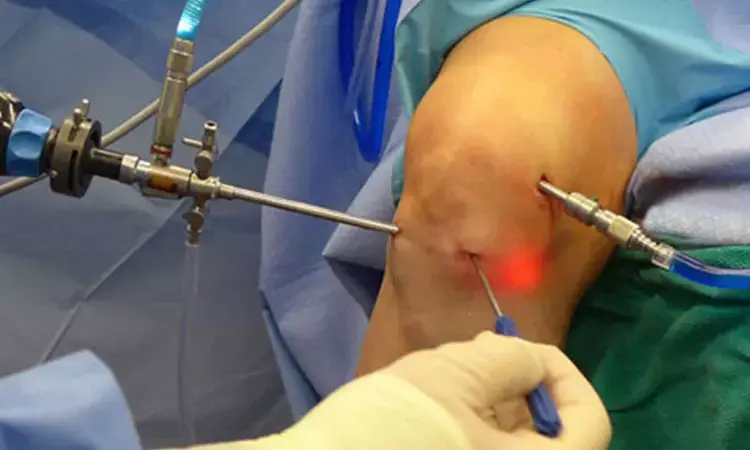- Home
- Medical news & Guidelines
- Anesthesiology
- Cardiology and CTVS
- Critical Care
- Dentistry
- Dermatology
- Diabetes and Endocrinology
- ENT
- Gastroenterology
- Medicine
- Nephrology
- Neurology
- Obstretics-Gynaecology
- Oncology
- Ophthalmology
- Orthopaedics
- Pediatrics-Neonatology
- Psychiatry
- Pulmonology
- Radiology
- Surgery
- Urology
- Laboratory Medicine
- Diet
- Nursing
- Paramedical
- Physiotherapy
- Health news
- Fact Check
- Bone Health Fact Check
- Brain Health Fact Check
- Cancer Related Fact Check
- Child Care Fact Check
- Dental and oral health fact check
- Diabetes and metabolic health fact check
- Diet and Nutrition Fact Check
- Eye and ENT Care Fact Check
- Fitness fact check
- Gut health fact check
- Heart health fact check
- Kidney health fact check
- Medical education fact check
- Men's health fact check
- Respiratory fact check
- Skin and hair care fact check
- Vaccine and Immunization fact check
- Women's health fact check
- AYUSH
- State News
- Andaman and Nicobar Islands
- Andhra Pradesh
- Arunachal Pradesh
- Assam
- Bihar
- Chandigarh
- Chattisgarh
- Dadra and Nagar Haveli
- Daman and Diu
- Delhi
- Goa
- Gujarat
- Haryana
- Himachal Pradesh
- Jammu & Kashmir
- Jharkhand
- Karnataka
- Kerala
- Ladakh
- Lakshadweep
- Madhya Pradesh
- Maharashtra
- Manipur
- Meghalaya
- Mizoram
- Nagaland
- Odisha
- Puducherry
- Punjab
- Rajasthan
- Sikkim
- Tamil Nadu
- Telangana
- Tripura
- Uttar Pradesh
- Uttrakhand
- West Bengal
- Medical Education
- Industry
Slope reducing osteotomy useful option for revision ACL reconstruction if posterior tibial slope more than 12degrees

While the literature suggests a correlation between posterior tibial slope (PTS) and sagittal stability of the knee, there is a lack of consensus relating to how to measure the slope, what a normal slope value would be, and which critical values should guide extra surgical treatment.
Vipul Mandalia et al performed a systematic literature review looking at the posterior tibial slope and cruciate ligament surgery. The study has been
Electronic searches of MEDLINE (PubMed), CINAHL, Cochrane, Embase, ScienceDirect, and NICE in June 2020 were completed. Inclusion criteria were original studies in peer-reviewed English language journals. A quality assessment of included studies was completed using the Methodological Index for Non-Randomized Studies (MINORS) Criteria.
Key findings of the study:
• Two-hundred and twenty-one papers were identified; following exclusions 34 papers were included for data collection.
• The mean MINORS score was 13.8 for non-comparative studies and 20.4 for comparative studies, both indicating fair to good quality studies.
• Thirty of the papers included were level 3evidence and one paper was level 2 evidence.
• A large variation in the posterior tibial slope measurement technique was identified, resulting in a wide range of values reported.
• A significant variation in slope value also existed between different races, ages and genders.
“To calculate “normal” values for PTS a standardised methodology must exist. Typically short lateral radiographs and MRI scans are the most frequently used imaging modalities for cruciate surgery. Therefore, an ideal method of measuring PTS should consider this and be reliably transferable between the two. The proximal tibial axis has been shown to be the closest surrogate to the true mechanical axis and should, therefore, be adopted for regular use, ideally with two central reference points at 5 and 15 cm from the joint line. Based on the available literature normal ranges of 6-12º using the proximal tibia axis at 5 and 15 cms below the joint” the authors commented.
Cautiously, the authors suggest a normal range of 6-12º, using the proximal tibial axis at 5 and 15 cms below the joint. The authors suggest 12º as a cut-off value for slope-reducing osteotomy as an adjunct to revision ligament reconstruction.
For details of steps please refer to:
Posterior Tibial Slope in Anterior Cruciate Ligament Surgery: A Systematic Review
Vipul Mandalia, Morgan Bayley
Indian Journal of Orthopaedics (2023) 57:1376–1386
https://doi.org/10.1007/s43465-023-00947-x
MBBS, Dip. Ortho, DNB ortho, MNAMS
Dr Supreeth D R (MBBS, Dip. Ortho, DNB ortho, MNAMS) is a practicing orthopedician with interest in medical research and publishing articles. He completed MBBS from mysore medical college, dip ortho from Trivandrum medical college and sec. DNB from Manipal Hospital, Bengaluru. He has expirence of 7years in the field of orthopedics. He has presented scientific papers & posters in various state, national and international conferences. His interest in writing articles lead the way to join medical dialogues. He can be contacted at editorial@medicaldialogues.in.
Dr Kamal Kant Kohli-MBBS, DTCD- a chest specialist with more than 30 years of practice and a flair for writing clinical articles, Dr Kamal Kant Kohli joined Medical Dialogues as a Chief Editor of Medical News. Besides writing articles, as an editor, he proofreads and verifies all the medical content published on Medical Dialogues including those coming from journals, studies,medical conferences,guidelines etc. Email: drkohli@medicaldialogues.in. Contact no. 011-43720751


